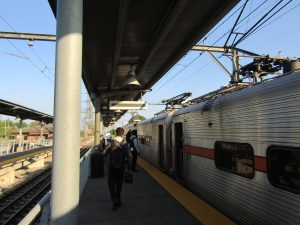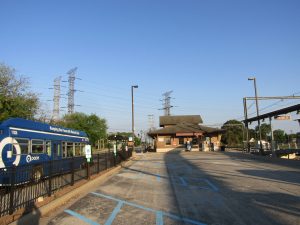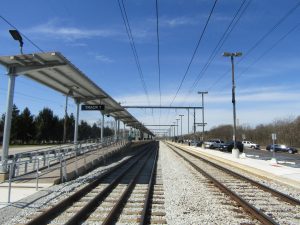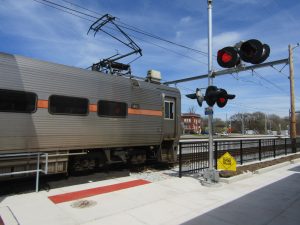South Shore Line doubles up on tracks
By Igor Studekov For Chronicle Media — May 21, 2024
South Shore riders disembark at the Hegewisch station. (Photo by Igor Studenkov/for Chronicle Media)
South Shore Line commuters’ trips have gotten almost a half-hour faster between Chicago and Northwest Indiana thanks to the years-long double-tracking project.
In February 2022, the Northern Indiana Commuter Transportation District, the agency that runs the passenger railroad, began work on adding a second track to a largely single-track section between downtown Gary, Indiana and Uptown Michigan City, Indiana. The aim was to eliminate bottlenecks, add high-level platforms to some stations that didn’t have them before, allow NICTD to run more trains and decrease travel times between Chicago and Michigan City.
The rest of the line between Michigan City’s Carroll Avenue station and the South Bend International Airport remains single-tracked.
The double-tracking project concluded on April 9, but it wasn’t until May 14 that South Shore Line debuted a new schedule that took advantage of the extra capacity. On weekends, the line now runs a total of 29 westbound trains, up from 21, and 30 eastbound trains, up from 22.
The new schedule adds midday and reverse commuter options, including more express trains in both

The Pace Route 368 bus waits to pick up passengers at the Hegewisch station. (Photo by Igor Studenkov/for Chronicle Media)
directions. For weekend schedules, the changes were mostly adjusting arrival times to account for faster trips.
Overall, the travel times between the Loop and Michigan City went from anywhere between 90-120 minutes to an average of 78 minutes. For riders traveling between the city and the South Bend airport, the travel times went from around 2½ hours to closer to two hours. Even Chicago riders get benefits, thanks to more express trains.
South Shore Line runs between Chicago and South Bend International Airport, though most weekday trains only travel between Chicago and Gary or between Chicago and Michigan City. The line serves the Indiana Dunes National Park and provides passenger rail service in the Hegewisch neighborhood on Chicago’s southeast edge.

The new Portage/Ogden Dunes station. (Photo by Igor Studenkov/for Chronicle Media)
The double-tracking project made several notable improvements. The line used to travel through most of Michigan City on a single track in the middle of the street. NICTD reduced those streets to one lane and put in two tracks, and built a full-fledged station in Uptown, the city’s central neighborhood, complete with high-level platforms and shelters. The Miller station in Gary’s Miller Beach neighborhood was completely rebuilt as well, also getting high-level platforms. Portage/Ogden Dunes station got one high-level platform as well. This makes the line more accessible to riders with disabilities and give bicyclists more options. NICTD doesn’t allow cyclists to bring their bikes on board at stations with low-level platforms, but with the majority of stations getting high-level platforms, it is now allowing bikes on the trains throughout the year, not just April through October.
Under the old schedule, Chicago-Gary trains didn’t go past downtown Gary Metro Center station. But with Miller station getting new storage tracks, those trains now serve all Gary stations.
The number of weekday trains traveling the entire length of the line hasn’t changed — it’s still five trains a day in each direction. But whereas before, most of those trains stopped at both Michigan City stations — the 11th Street and Carroll Avenue station — they now only stop at the Uptown station. Michigan City Transit’s Route 3 runs between the two stations, but the system stops running at 6 p.m.
Most of the new weekday trains increase reverse commuter options. Commuter railroads serving Chicago traditionally focused on getting rides to the city in the morning and out of the city in the afternoon.
The new South Shore Line schedule takes a more balanced approach. For example, the earliest
option for riders traveling from the Loop to Michigan City didn’t reach the 11th Street station until 10:36 a.m. The new schedule adds a train that arrives at 8:39 a.m.
That isn’t to say the new schedule neglects traditional commuters. Hegewisch riders heading to

An eastbound South Shore Line train leaves the new Miller station. (Photo by Igor Studenkov/for Chronicle Media)
Chicago in the morning get an extra morning trip option, and, because most inbound trains skip every stop until the Loop, the trip is about six minutes shorter.
Pace suburban bus service has two routes that link the Hegewisch station to suburbs farther south. Route 358 mostly serves the Torrence Avenue corridor in suburbs such as Burnham, Calumet City, Lansing and Lynnwood before turning west to serve Chicago Heights.
Route 364 only serves the station on weekends, connecting it to Calumet City, South Holland, Harvey, Oak Forest and Orland Park. The current schedules are not designed to match South Shore Line’s, so the effects on the transfers is a mixed bag. In some situations, riders would need to wait longer, but thanks to more reverse-commuting trains, some riders now have more options.
In a statement shared on South Shore Line’s social media channels, NICTD executive director Mike Noland thanked the riders for the patience with the project and touted the benefits — more frequent, more realiable service.
“We hope that each of our riders gets to experience the benefits of this new project,” he said. “At the South Shore Line, we’re connecting people, places and lives better than ever.”







